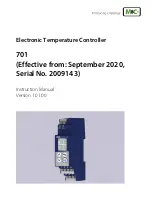
2
-30
Control Circuit Wiring Precautions
Observe the following precautions when wiring control circuits.
•
Separate control circuit wiring from main circuit wiring (terminals R/L1, S/L2, T/L3, B1, B2, U/T1, V/T2,
W/T3, , 1, 2,
and 3)
and
other
high-power
lines.
•
Separate wiring for control circuit terminals MA, MB, MC, M1, M2, M3, M4, M5, and M6 (contact
outputs) from wiring to other control circuit terminals.
•
Use twisted-pair or shielded twisted-pair cables for control circuits to prevent operating faults. Process
cable ends as shown in
•
Connect the shield wire to terminal E (G).
•
Insulate the shield with tape to prevent contact with other signal lines and equipment.
Fig 2.17 Processing the Ends of Twisted-pair Cables
Control Circuit Wire Sizes
For remote operation, keep the length of the control wiring to 50m or less. Separate the control wiring from high-
power lines (input power, motor leads or relay sequence circuits) to reduce noise induction from peripheral devices.
When setting speed commands from an external speed potentiometer, use shielded twisted-pair wires and ground the
shield to terminal E(G), as shown above
.
Terminal numbers and wire sizes are shown in Table 2.9.
Wiring Checks
Check all wiring after wiring has been completed. Do not perform a buzzer check on control circuits. Perform
the following checks on the wiring.
•
Is all wiring correct?
•
Have any wire clippings, screws, or other foreign material been left?
•
Are all screws tight?
•
Are any wire ends contacting other terminals?
Shield sheath
Armor
Connect to shield sheath
terminal at Drive
(terminal E (G))
Insulate with tape
Do not connect here.
Summary of Contents for CIMR-G7U
Page 2: ......
Page 7: ...v...
Page 32: ...1 18...
Page 90: ...3 16...
Page 112: ...4 22...
Page 382: ...6 164...
Page 410: ...7 28...
Page 454: ......
Page 455: ......
















































